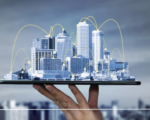A tool that monitors your location and immediately alerts authorities could either be a public-health carrot or an authoritarian stick.
Even if it were to end today, the COVID-19 crisis will leave an indelible imprint on the infrastructure of our lives. In addition to the painted lines, warning signs, and other low-tech indicators that attempt to keep people safely separated, we’re seeing greater interest in technological solutions to enforce quarantines of infected individuals and keep the coronavirus from spreading in crowds.
Geofencing for quarantine management
Although much attention has gone to contact tracing as a tool for tracking the virus’s spread, geofencing is a potentially more useful tool for enforcing these curve-flattening practices at the larger societal level, in every home, office, or other facility.
Geofencing systems monitor and enforce the virtual boundaries within which mobile, edge, and other devices—and their associated human users—roam. These systems can take various programmatic actions, such as sending an alert message, loading a device-level user interface, or issuing robotic commands when a device enters, exits, or moves around in a prespecified zone, as indicated by its GPS, RFID, Wi-Fi, and/or Bluetooth coordinates.
Chief providers of geofencing solutions are Thumbvista, Simpli.fi, ESRI, GeoMoby, Apple, Pulsate, Mapcite, Swirl Networks, Bluedot, Mobinius, GPSwox, and Localytics.
The true power of geofencing lies in its ability to dynamically evolve the embedded rules, machine learning models, and other artifacts that constitute the social-distancing logic being enforced. Where management of COVID-19 quarantines is concerned, geofencing can be set up with human response loops. It can trigger a friendly reminder call or take a more stringent, systemic response, such as locking the doors of an isolation ward to prevent infected people from walking out.
Here’s one example of a geofenced human response loop. The Irish telecommunications company Hubbcat has proposed using geofencing to keep track of quarantined travelers who arrive in the country. The system was trialed in the Bahamas and is under evaluation by the Irish government. Arriving travelers would be required to download a Hubbcat geofencing app. Once the app is set up on a traveler’s smartphone, it would allow Irish authorities to create a virtual perimeter around the territory or facilities (such as a house or hotel) where travelers will be self-isolating during the required quarantine period.
If Hubbcat’s geofence were breached, it would automatically trigger an alarm that puts an Irish public health supervisor immediately in voice contact with the individual. This would provide a channel for the authorities to remind people to comply with the quarantine. It could also be set up so that public health supervisors can regularly ask whether individuals are showing symptoms or taking ill, in which case they would be directed to the nearest hospital for potentially life-saving treatment.
A more assertive use of geofencing applications for COVID-19 quarantining has been developed in India. A team of researchers is piloting a mobile app that tracks compliance with home quarantines by COVID-19 patients. Also discussed here, the LakshmanRekha application:
- Requires users to share their geolocations and upload selfies periodically throughout the day
- Uses AI to match the user’s designated quarantine geofence with the places from which he or she has uploaded the required selfies
- Continually verifies that the quarantined user is the one using the mobile device
- Notifies the authorities to take action if a user identity has been changed or the authenticated user/device roams beyond the quarantine’s geofence
Geofencing for other aspects of future society
Geofencing will almost certainly remain in place long after the current outbreak has subsided. Once they’ve taken root for a specific application, such as to enforce COVID-19 quarantine restrictions, these systems can continue to evolve to address future requirements that have nothing to do with flattening the curve.
In fact, we’ve seen uses of geofencing during the past year that touch on various aspects of what one might consider the eventual post-pandemic new normal.
Geofencing can be an important infrastructure for minimizing face-to-face interactions when we dine out, go to the supermarket, or otherwise try to carry on life as usual. Implemented through self-service apps, geofencing enables commercial establishments to serve their mobile-order customers while complying with social distancing imperatives. The technology can alert merchants when customers approach so that orders can be filled before people enter the brick-and-mortar environment, hence shortening on-site waiting and reducing occupancy in the nick of time. Geofencing can also automatically check in customers who opt for curbside pickup, shortening service latencies while keeping everybody safe.
Geofencing also has clear applications in work-from-home and other distributed location scenarios. Without requiring site administrators to enforce safety practices at each location, the technology can be used for automatic check-in/check-out of workers and visitors who’ve tested negative. It can show visitors important information about COVID-19 safety and mandatory processes at or before check-in. And it can determine occupancy of these sites in real time in order to issue evacuation and distancing instructions if infected individuals happen to arrive in the vicinity.
Potential pitfalls of geofencing surveillance
For all its valuable protective applications during the COVID-19 crisis, geofencing infrastructure can just as easily be used for purposes that some might regard as destructive to civil liberties and other pillars of democratic society.
The geofencing concept of a containment zone is either benign or troublesome, depending on your perspective. If backed by the force of law, virtual perimeters can easily be used for surveillance and control of the most intrusive kind. It’s not hard to envision geofencing as the foundation for centralized imposition of “house arrest” on wide swaths of populations living under totalitarian regimes.
The practical boundary between justified use of geofencing for public health monitoring and unwarranted use for societal surveillance and control can be slippery. What accentuates the downside threat to civil liberties are the efficiencies that come with using geofencing to automate these functions over wireless networks.
For example, a socially benign geofencing application allows India’s police to determine when individuals have fled from COVID-19 isolation wards so that they can be apprehended and returned to the institutions from which they escaped. Authorities in India’s Kerala state are using geofencing to track the movement of people in quarantine and to notify authorities in real time via email and SMS when someone breaks out of a geofence or is likely to do so. Likewise, authorities in Bengaluru and Tamil Nadu states are also reportedly evaluating the use of geofences to enforce quarantines.
However, the superintendent of police in one Tamil Nadu city went on record as dismissing concerns over civil liberties. He stated, “when the larger welfare of society is at stake, issues like individual privacy should take a back seat.”
In the earlier stage of the pandemic, Hong Kong required geofencing wristbands that warned the wearer and alerted the authorities if an infected individual had violated the requisite 14-day quarantine period. These wristbands contained a QR code paired with a StayHomeSafe smartphone app, using Wi-Fi, Bluetooth, and GPS signals to track a person’s location.
The Hong Kong government contended that the wristband did not raise privacy issues because it did not track a person’s exact location but simply whether someone was inside or outside of their home. When the quarantine ended, people could cut the bracelet with a pair of scissors and delete the app.
A tool that helps or harms
Containment will become a fundamental requirement in the coming society. Public and private infrastructure will need to be able to contain COVID-19 and other contagions by enforcing a protective bubble around vulnerable human beings. But containment is a double-edged sword. No one wishes to be contained unless it is justified by some compelling need, such as warding off a life-threatening disease.
The civil liberties concerns surrounding geofencing go beyond privacy and surveillance. The technology potentially infringes on other activities—constitutional and otherwise—that many people cherish:
- If you’re a Second Amendment absolutist, you might be concerned about potential restrictions on the right to bear arms that could be implemented if geofencing is used with locationized firearms. Potentially, geofencing might restrict those firearms to discharge only in permitted locations rather than where their owner/operator chooses.
- If the freedom to travel is your passion, you might be concerned about the potential for geofencing to be used with GPS-based automotive navigation systems. Such systems could restrict your ability to drive anywhere you wish in your community, across your country, or internationally.
- If you’re disabled or elderly, you might chafe at geofenced equivalents of the GPS-based tracking devices that are designed to help you but might impose overly restrictive rules on your mobility and ability to engage in activities that you love.
In coming years, we’ll see a lot of innovative uses of geofencing to protect our health and safety, deliver targeted offers and experiences, and otherwise improve our quality of life. Quarantine is a necessary evil and an important, protective use of geofencing. But let’s make sure we don’t inadvertently use these virtual perimeters to contain and constrain free society in a well-intentioned dystopia.








